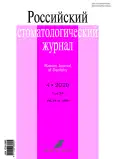Interdisciplinary approach to the rehabilitation of patients with temporoman-dibular joint abnormality, and a need for complete dental reconstruction: out-comes
- Authors: Dzalaeva F.K.1, Chikunov S.O.2,3, Utyuzh A.S.2, Mikhailova M.V.2, Budunova M.K.2
-
Affiliations:
- First Moscow State Medical University (Sechenov University)
- First Moscow State Medical University
- Peoples’ Friendship University of Russia
- Issue: Vol 24, No 4 (2020)
- Pages: 211-218
- Section: Clinical Investigations
- Submitted: 14.12.2020
- Accepted: 14.12.2020
- Published: 15.08.2020
- URL: https://rjdentistry.com/1728-2802/article/view/55089
- DOI: https://doi.org/10.17816/1728-2802-2020-24-4-211-218
- ID: 55089
Cite item
Abstract
Background. This study aimed to improve the clinical effect of dental orthopedic treatment for patients who need a complete dental reconstruction, by making use of the temporomandibular joint characteristics.
Materials and Methods. A total of 647 patients with adentia who needed a complete dental reconstruction were exposed to a comprehensive examination and treatment. Patients were divided into 3 groups: orthopedic rehabilitation group (218 patients), interdisciplinary rehabilitation group (195 patients), and multidisciplinary rehabilitation group (234 patients). The follow-up period was 7 years.
Results. After the proposed rehabilitation approach, patients in the main group demonstrated an improvement in the VAS (Visual Analogue Scale) score, which was significantly smaller with respect to that in the comparison groups. The frequency of clicking and pain during chewing as well as soreness sensations in this group decreased at a significantly lower pace compared to that in the comparison groups.
Conclusions. Dental reconstruction procedures aimed at restoring the shape of the teeth should focus on pain relief and temporomandibular joint function correction. The most important stage in implementing this approach is a complete and consistent examination of patients who need dental reconstruction.
Full Text
About the authors
Fatima K. Dzalaeva
First Moscow State Medical University (Sechenov University)
Author for correspondence.
Email: dzalayevaf1627@bk.ru
SPIN-code: 6498-6901
PhD, Doctor of Philosophy, Professor of the Department of Prosthodontics
Russian Federation, MoscowS. O. Chikunov
First Moscow State Medical University; Peoples’ Friendship University of Russia
Email: dzalayevaf1627@bk.ru
Russian Federation, 119146, Moscow; 117198, Moscow
A. S. Utyuzh
First Moscow State Medical University
Email: dzalayevaf1627@bk.ru
Russian Federation, 119146, Moscow
M. V. Mikhailova
First Moscow State Medical University
Email: dzalayevaf1627@bk.ru
Russian Federation, 119146, Moscow
M. K. Budunova
First Moscow State Medical University
Email: dzalayevaf1627@bk.ru
Russian Federation, 119146, Moscow
References
- Iordanishvili AK, Serikov AA. About the necessity of standardization of approaches to treatment and rehabilitation of patients with temporomandibular joint pathology in the institutions with different forms of property. Meditsinskii vestnik Severnogo Kavkaza. 2018;13(1–1):59–62. (in Russian). doi: 10.14300/mnnc.2018.13017.
- Bulycheva EA, Chikunov SO, Alpat'eva YuV. Development of a rehabilitation therapy system for patients with various clinical forms of diseases of the temporomandibular joint complicated by muscle hypertension (Part II). Institut stomatologii. 2013;(1):76–7. (in Russian)
- Verbitskaya LP, Nersesyants SA, Nanavyan LA. Our practice in curing patients with pathological condition of temporomandibular joint. Glavnyi vrach Yuga Rossii. 2018;(5):32–6. (in Russian)
- He H, Liu ZJ. Risk of temporomandibular joint and its management in orthodontic treatment. Zhonghua Kou Qiang Yi Xue Za Zhi. 2019;54(12):808–14. (in Chinese). doi: 10.3760/cma.j.issn.1002–0098.2019.12.004.
- de Barros Pascoal AL, de Freitas RF, da Silva LF, Oliveira AG, Calderon PD. Effectiveness of counseling on chronic pain management in patients with temporomandibular disorders. J. Oral Facial Pain Headache. 2020;34(1):77–82. doi: 10.11607/ofph.2163.
- Domenyuk DA, Davydov BN. Konnov VV, Vedeshina EG. The morphology of the temporomandibular joint in normal occlusion and distal occlusion complicated by defects of dentitions. Institut stomatologii. 2017;(2):66–9. (in Russian)
- Novikov VM, Rybalov OV, Yatsenko OI, Yatsenko PI. Asymmetry in size and shape of articular heads a cause of compression and dislocation dysfunction of temporomandibular joint. Aktual'nі problemi suchasnoї meditsini: Vіsnik ukraїns'koї medichnoї stomatologіchnoї akademії. 2017;17(2):251–5. (in Rus-sian)
- Ordokova ER. Diagnosis and treatment of temporomandibular joint dysfunction in patients with malocclusion. Smolenskii meditsinskii al'manakh. 2018;(2):55–7. (in Russian)
- Kretschmer WB, Baciuţ G, Baciuţ M, Sader, R. Effect of bimaxillary orthognathic surgery on dysfunction temporomandibular joint: a retrospective study of 500 consecutive cases. Brit. J. Oral Max. Surg. 2019;57(8):734–9. doi: 10.1016/j.bjoms.2019.06.010.
- Ghurye S, McMillan R. Orofacial pain: an update on diagnosis and management. Br. Dent. J. 2017;223(9):639–47. doi: 10.1038/sj.bdj.2017.879.
- Gil-Martinez A, Paris-Alemany A, Lopez-de-Uralde-Villanueva I, La Touche R. Management of pain in patients with temporomandibular disorder (TMD): challenges and solutions. J. Pain Res. 2018;11:571–87. doi: 10.2147/JPR.S127950.
- Balaji SM. Bilateral pediatric mandibular distraction for micrognathia with temporomandibular joint ankylosis and sleep apnea. Indian J. Dent. Res. 2017;28(5):588–91. doi: 10.4103/ijdr.IJDR_412_17.
- Furlan RM, Giovanardi RS, Britto AT. The use of superficial heat for treatment of temporomandibular disorders: an integrative review. Codas. 2015;27(2):207–12. doi: 10.1590/2317–1782/20152014148.
- Paco M, Chaves P, Pinho F, Lemos C, Costa R, Duarte JA, et al. Common symptoms of temporomandibular disorders do not mean same treatment plans: a case series. Int. Orthod. 2018;16(1):174–214. doi: 10.1016/j.ortho.2018.01.029.
- Milosevic A. Abrasion: a common dental problem revisited. Prim. Dent. J. 2017;6(1):32–6. doi: 10.1177/205016841700600104.
- Lai YC, Yap AU, Turp JC. Prevalence of temporomandibular disorders in patients seeking orthodontic treatment: a systematic review. J. Oral. Rehabil. 2020;47(2):270–80. doi: 10.1111/joor.12899.
- Utyuzh AS, Yumashev AV, Zagorskij VV, Lushkov RM, Nefedova IV. Clinical aspects of biomechanics for implants joined in unit. Sovremennaya nauka: aktual'nye problemy teorii i praktiki. Seriya: Estestvennye i tekhnicheskie nauki. 2016;(7):92–7. (in Russian)
- Trezubov VN, Chikunov SO, Bulycheva EA, Alpat'eva YuV, Bulycheva DS. Step by step modeling of dentition in difficult clinical picture. Klinicheskaya stomatologiya. 2017;(3):60–3. (in Russian)
- Chikunov SO. Instrumental-surgical treatment of a patient with a complex clinical picture of dentoalveolar anomaly. Institut stomatologii. 2013;(1):58–9. (in Russian)
Supplementary files












